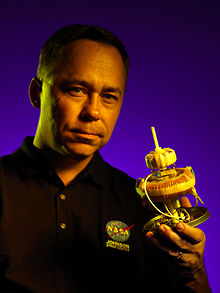哈羅德·G·懷特
| 哈羅德·懷特 Harold White | |
|---|---|
 | |
| 出生 | Harold Sonny White 1965年10月8日 |
| 國籍 | |
| 母校 | 南阿拉巴馬大學(BS) 衛奇塔州立大學(MS) 萊斯大學(PhD) |
哈羅德·G·「桑尼」·懷特(英語:Harold G. "Sonny" White,1965年10月8日—)是一名美國機械工程師、航空航天工程師和應用物理學家,因提出新的阿庫別瑞引擎概念和推動先進的推進系統項目而知名。
教育
[編輯]懷特獲得南阿拉巴馬大學機械工程學士學位,1999年獲得衛奇塔州立大學機械工程碩士學位[1],2008年獲得萊斯大學物理學博士學位[2][3]。
阿庫別瑞引擎
[編輯]懷特開始在太空大會上展示自己的想法,並發表關於阿庫別瑞引擎概念的提案,從而引起媒體的關注。2011年,他發表了一篇題為《曲速場力學101》(Warp Field Mechanics 101)的論文,概述了米給爾·阿庫別瑞的超光速推進系統概念的更新理念,包括證明專案可行性的方法。阿庫別瑞的概念曾被認為是不可行的,因為它所需的能量遠遠超過任何可行能源所能產生的能量。懷特重新計算了阿庫別瑞的概念,並提出如果太空船周圍的曲速氣泡形狀像一個環面,就會更加節能,使這個概念變得可行。懷特表示「曲速旅行」還沒有進行過「芝加哥1號堆」實驗,這指的是第一個核子反應爐,是為核能鋪平道路的突破性演示[4][5][6]
為了研究曲速引擎的可行性,懷特和他的團隊設計了一個曲速場干涉儀試驗台來展示曲速場現象[5]。實驗在美國國家航空暨太空總署林登·詹森太空中心的先進推進物理實驗室("Eagleworks")進行。懷特和他的團隊聲稱,這種改進的邁克生干涉儀可以探測到時空的扭曲,即曲場效應[7]。
2021年5月,懷特和他的團隊宣布他們可能已經找到了測試「晶片級」阿庫別瑞引擎所需的正確配置[8][9][10][11]。
電磁推進器
[編輯]2015年4月,太空愛好者網站NASASpaceFlight.com根據NASA Eagleworks工程師保羅·馬奇(Paul March)在其網站論壇上發表的一篇帖子宣布,美國國家航空暨太空總署已成功在硬真空中測試他們的電磁推進器——這將是任何組織首次宣稱此類測試成功[12]。2016年11月,懷特與NASA Eagleworks計畫的其他同事一起發表了他們對擬議中的電磁推進器的研究結果[13]。事實證明,這種裝置的建議工作原理不符合已知的物理定律,包括動量守恆和能量守恆。目前還沒有為這種推進器提出任何可信的運行理論[14][15][16][17][18][19]
2021年3月,德勒斯登工業大學的物理學家發表了三篇論文,聲稱所有顯示推力的結果都是假陽性,是由外力造成的[20]。
其他工作
[編輯]懷特和他的團隊也正在研究其他幾個「突破性空間技術」項目,其中包括一個新的推進器概念,懷特稱這個概念是利用量子力學預測的效應來工作的。為了支持這項研究,懷特的團隊也正在開發一種「微型天平」,它能夠測量這種推進器預計產生的極其微小的力。為了校準這個天平,研究團隊計劃重複2006年不成功的伍德沃德效應實驗,這次將使用新的微型天平[21]。
榮譽
[編輯]2006 年,懷特被美國國家航空暨太空總署署長授予NASA傑出成就獎,以表彰他在太空梭返航期間為隔熱系統機器人檢查工具的製造、交付和認證所發揮的作用[3]。懷特也因「在執行STS-121太空梭任務前發現並處理機械手臂的嚴重損壞」而獲得美國國家航空暨太空總署機組辦公室頒發的銀史努比獎[3]。
參考資料
[編輯]- ^ Personnel page 網際網路檔案館的存檔,存檔日期2017-04-26. - website of the Department of Mechanical Engineering of Wichita State University
- ^ Graduate Study Recent Theses 網際網路檔案館的存檔,存檔日期2013-09-21. - website of the Physics and Astronomy Department of Rice University
- ^ 3.0 3.1 3.2 Icarus Interstellar. "Dr. Harold 'Sonny' White" 網際網路檔案館的存檔,存檔日期2015-06-01., Project Icarus.
- ^ Oswald, Ed. "NASA working on faster-than-light space travel, says warp drives are 'plausible'" (頁面存檔備份,存於網際網路檔案館), ExtremeTech.
- ^ 5.0 5.1 White, Harold. "Warp Field Mechanics 101" (頁面存檔備份,存於網際網路檔案館), NASA, Houston, TX.
- ^ A Discussion of Space-Time Metric Engineering (頁面存檔備份,存於網際網路檔案館) – Digital Library for Physics and Astronomy of Harvard University
- ^ Dvorsky, George. "How NASA might build its very first warp drive" (頁面存檔備份,存於網際網路檔案館), io9.
- ^ Williams, Matt. The Dream of Faster-than-Light (FTL) Travel: Dr. Harold “Sonny” White and Limitless Space. Universe Today. 27 May 2022 [14 March 2023]. (原始內容存檔於2023-09-21).
… in the process of looking at how the vacuum responds to these shapes, he and his team noticed something completely unexpected: 『The custom Casimir cavities consist of two plates, and in between the two plates, we have pillars. When we were looking at how the models we have predicted how the quantum vacuum responds to those pillar-plate geometries – when we looked at a two-dimensional section cut of the vacuum energy distribution, it looked like a two-dimensional section cut of the energy density distribution needed for the Alcubierre Warp Metric.』
- ^ Ankers-Range, Adele. Scientists Take a Step Towards Building a Real-Life Warp Drive... By Accident. IGN. 31 December 2021 [14 March 2023]. (原始內容存檔於2023-03-28).
- ^ Coontz, Lauren. DARPA and NASA Scientists Accidentally Create Warp Bubble for Interstellar Travel. Coffee or Die Magazine. Black Rifle Coffee Company. 9 December 2021 [14 March 2023]. (原始內容存檔於2023-11-14).
- ^ White, Harold; Vera, Jerry; Han, Arum; Bruccoleri, Alexander R.; MacArthur, Jonathan. Worldline numerics applied to custom Casimir geometry generates unanticipated intersection with Alcubierre warp metric. European Physical Journal C. 17 May 2021, 81 (7): 677–686 [14 March 2023]. doi:10.1140/epjc/s10052-021-09484-z
 . (原始內容存檔於2023-11-25).
. (原始內容存檔於2023-11-25). The qualitative correlation would suggest that a chip-scale experiment might be explored to attempt to measure a tiny signature illustrative of the presence of the conjectured phenomenon
- ^ http://www.nasaspaceflight.com/2015/04/evaluating-nasas-futuristic-em-drive/ (頁面存檔備份,存於網際網路檔案館) Evaluating NASA’s Futuristic EM Drive
- ^ White, Harold; March, Paul; Lawrence, James; Vera, Jerry; Sylvester, Andre; Brady, David; Bailey, Paul. Measurement of Impulsive Thrust from a Closed Radio-Frequency Cavity in Vacuum. Journal of Propulsion and Power. 2017, 33 (4): 830–841. S2CID 126303009. doi:10.2514/1.B36120. hdl:2060/20170000277
 .
.
- ^ The Impossible Propulsion Drive Is Heading to Space. popularmechanics.com. 2 September 2016 [9 October 2017]. (原始內容存檔於2023-11-11).
- ^ Crew, Bec. The 'Impossible' EM Drive Is About to Be Tested in Space. sciencealert.com. [9 October 2017]. (原始內容存檔於2023-12-16).
- ^ NASA Team Claims 'Impossible' Space Engine Works—Get the Facts. National Geographic. 21 November 2016 [9 October 2017]. (原始內容存檔於2016-11-22).
- ^ Seeker. How The 'Impossible Drive' Could Break Newton's Third Law. 19 November 2016 [9 October 2017]. (原始內容存檔於2023-11-11) –透過YouTube.
- ^ Ratner, Paul. EM Drive, the Impossible Rocket Engine, May Be Closer to Reality. bigthink.com. 2016-09-07 [2023-10-16]. (原始內容存檔於2021-07-29).
- ^ Poitras, Colin. To Mars in 70 days: Expert discusses NASA's study of paradoxical EM propulsion drive. Phys.org. 7 December 2016 [1 May 2018]. (原始內容存檔於2023-11-11).
- ^ Delbert, Caroline. Scientists Just Killed the EmDrive. popularmechanics.com. Popular Mechanics. 31 March 2021 [29 June 2021]. (原始內容存檔於2021-04-21).
- ^ Eagleworks Laboratories: Advanced Propulsion Physics Research (PDF). NASA. 2 December 2011 [10 January 2013]. (原始內容存檔 (PDF)於2023-11-11).
